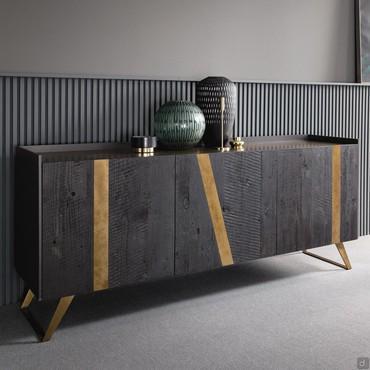Technical Specifications and Equipment
Doors: 20/10 oak plated mdf doors, with oak edging. Brushed finish.
Material finish structure: material melamine edged panels with ABS edge. Exclusive use of water-based vinyl glues and ureic resins, conforming to UNI-CEE regulations.
Wooden structure: sides, bottom cover and shelves in 12/10 oak veneered fir planking, back in 6/10 oak veneered plywood. Outer sides and top in brushed finish.
Metal bases: in powder-coated or oxidised steel with acrylic finish.
Optional metal or ceramic top: in oxidised steel sheet with acrylic finish, or in 0.6 cm thick porcelain stoneware.
Read more...
Wood: is a noble and natural material, whose strength and durability are guaranteed by a careful selection process and skilful craftsmanship. It is a living material, which evolves over time and changes in symbiosis with its environment: small irregularities or surface imperfections are therefore not to be considered defects but characteristics that enhance the product's uniqueness and strictly natural origin. These peculiarities, which are never the same, can include small visual irregularities such as flaming, colour changes, knots and putty; or material ones, such as small holes, surface cracks and irregular edges.
Ceramic: obtained by coupling a 0.6 cm thick upper ceramic slab with a 0.8 cm thick lower glass support with a sloping edge or glued to a 3 cm thick lower MDF support.
Porcelain stoneware is a compact material resistant to chemical attack, scratching, wear and tear and high temperatures. On the outside, the most valuable features of the material are the variations in colour, veining and slight speckling: these are deliberate diversifications to recreate the randomness and beauty of natural materials.
Maintenance Tips
Wood: for daily cleaning use only a dry cotton cloth or, in the case of stubborn dirt, slightly moistened with lukewarm water and neutral soap. Always clean in the direction of the grain. Do not use microfibre cloths, degreasing agents, aggressive detergents, solvents, acetone, ammonia or steam cleaners. If stains appear on the surface, they must be cleaned promptly to prevent the stain from being absorbed by the wood. The surface must then be wiped with a dry cloth to prevent it from remaining damp.
Wood is particularly afraid of coloured and acidic products such as tomato, wine, coffee, cola or cooking fat. Sudden changes in temperature and contact with very hot or moist objects should also be avoided. The ideal room humidity for optimum storage of a wood complement is between 50 and 60%, in well ventilated rooms and not exposed to direct natural light.
Natural Bio Oak" wood with a natural oil finish: oil is a product that preserves the natural structure of the wood and protects the surface without clogging the pores, thus facilitating minor maintenance work. However, it is necessary, at least once a year, to regenerate the surface by applying a light coat of natural wood oil with a cotton cloth, following the direction of the grain. Using a dry cotton cloth, remove excess oil and allow to dry for at least 48 hours before resuming normal use.
Glass: avoid abrasive materials and liquids that can ruin or damage the surface. Instead, use a cloth soaked in water and alcohol, or specific products for cleaning glass.
Ceramics: when cleaning a ceramic countertop, use warm water and neutral detergents, such as those commonly used for kitchen countertops, using a microfibre cloth or soft sponges. After using a detergent, rinse the surface with water to avoid the formation of halos. Avoid shocks that could scratch the top, especially in the most delicate areas such as corners and edges. Do not load it with excessive weight or subject it to improper use, e.g. by climbing on it.
Metal: use a soft cloth slightly dampened with lukewarm water, with the possible addition of neutral soap to increase cleaning effectiveness. Then dry the surface with a dry cloth to prevent it from remaining damp. Prolonged presence of moisture may cause oxidation. Do not use degreasers, aggressive detergents, solvents, acetone, ammonia or steam cleaners.



